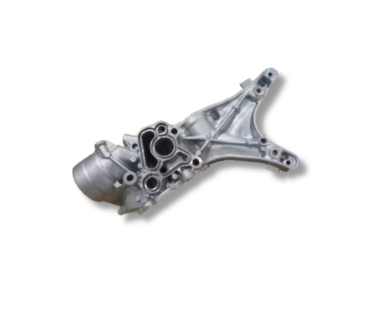Die casting is a kind of metal mold pressure casting on die casting machine, which is the current casting process. Die casting machine is divided into hot chamber die casting machine and cold chamber die casting machine. The hot chamber die casting machine has the advantages of high automation, less material loss and higher production efficiency than the cold chamber die casting machine. However, restricted by the heat resistance of the parts, it can only be used in the casting production of low melting point materials such as zinc alloy and magnesium alloy. Because of the high melting point, die casting parts widely used nowadays can only be produced on cold chamber die casting machine.
The main feature of die casting is that the liquid metal fills the mold cavity under high pressure and high speed, and forms and solidifies under high pressure. The disadvantage of die casting is that the air in the cavity is inevitably wrapped in the inner part of the casting to form subcutaneous blowholes during the filling process of liquid metal under high pressure and high speed. Therefore, the die casting parts are not suitable for heat treatment, and the surface of die castings is not suitable for plastic spraying (but can be sprayed) Paint). Otherwise, the air hole in the casting will expand with heat and cause deformation or bubbling. In addition, the machining allowance of die casting parts should be smaller, generally about 0.5mm, which can not only reduce the casting weight, reduce the cutting amount and reduce the cost, but also avoid penetrating the surface dense layer and exposing the subcutaneous pores, resulting in the scrapping of the workpiece.
Die casting is a process in which the metal is melted into the required liquid and poured into the mold. After cooling, solidification and cleaning, the castings with predetermined shape, size and performance can be obtained. Because the casting blank is nearly formed, it can achieve the purpose of no machining or a small amount of processing, which reduces the cost and reduces the production time to a certain extent. Casting is one of the basic technologies in modern device manufacturing industry.

Die casting parts are no longer limited to the automobile industry and instrument industry, but gradually expanded to other industrial sectors, such as agricultural machinery, machine tool industry, electronic industry, national defense industry, computer, instruments, clocks, cameras and daily hardware and other dozens of industries, including: auto parts, furniture accessories, bathroom accessories (bathroom), lighting parts, toys, shaving, tie clips, Electrical electronic parts, belt buckle, watch case, metal buckle, lock, zipper, etc. In the field of die casting technology, new technologies such as vacuum die casting, oxygen die casting, precision rapid die casting and the application of soluble core have appeared.
Die casting parts are widely used, in fact, a number of market segments have been formed in the die casting industry. At present, most of the small and medium-sized die-casting factories mainly produce ordinary die-casting products such as hardware, household appliances and lamps. The scale of enterprises is small, the equipment level is low, the price competition is fierce, and the enterprise benefit is low. And a few large-scale die-casting enterprises have more equipment and technology, which can meet the requirements of automobile industry, communication industry and other industries for high-precision die-casting products. This kind of manufacturers can establish stable long-term cooperative relationship with downstream customers, and they are in a favorable position in the market competition.
Die casting has good strength and can be heat treated to obtain good mechanical properties, physical properties and corrosion resistance, so it is widely used in mechanical manufacturing. So what should be paid attention to when the die casting is welded?
(1) Aluminum is easy to oxidize in air and welding, and the melting point of alumina is high and stable, which is difficult to eliminate, which hinders the melting and fusion of base metal. The oxide film on the surface of aluminum material and a large amount of water adsorbed on the surface of aluminum material can easily cause Blowholes in the weld. Chemical or mechanical methods should be used to strictly clean the surface of die castings before welding, and the oxide film on the surface of the die castings should be oxidized.
(2) In the welding process of aluminum and aluminum alloy, a large amount of heat can be transferred to the interior of the base metal. Therefore, when welding aluminum and aluminum alloy, more energy is consumed in other parts of the metal. In order to obtain the welding joint, energy with concentrated energy and high power or preheating should be adopted as far as possible.
(3) The volume shrinkage rate of aluminum solidification is large, and the deformation and stress of welding die casting are large. Therefore, it is necessary to take measures to prevent welding deformation. If the base metal of base metal is deformed or solution aged, the strength of HAZ will be decreased by welding heat. In production, the measures of adjusting the composition of welding wire and welding process can be adopted to prevent the generation of hot cracks.
(4) Aluminum has strong reflection ability to light and heat, and there is no obvious change of luster when the solid and liquid are in the state of transformation. It is difficult to judge during welding operation, and the alloy elements are easy to evaporate and burn out, which makes the weld performance decline.
(5) Aluminum and aluminum alloys can dissolve a lot of hydrogen in liquid state, but hardly in solid state. In the process of solidification and cooling of welding pool, hydrogen can not overflow in time, and hydrogen pores are easily formed. The formation of pores can be prevented by strictly controlling the source of hydrogen.
Contact person: Mr. Wang
Tel: 0512-52972252
Email: W wang@szypco.com
website: www.szypco.com
Address: No.10 WengZhuang Road, Shanghu Town, Changshu, Suzhou, Jiangsu Province


